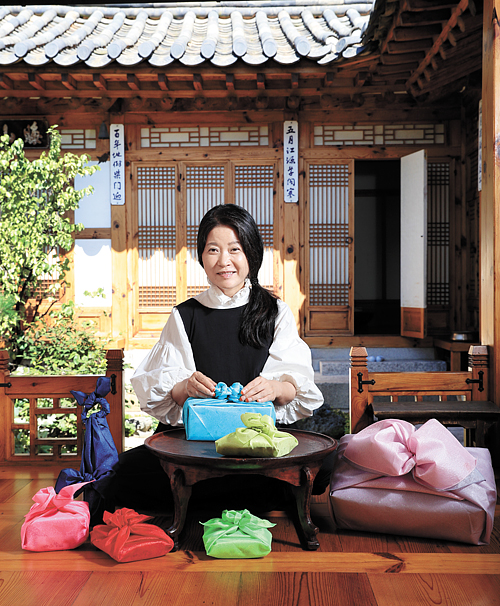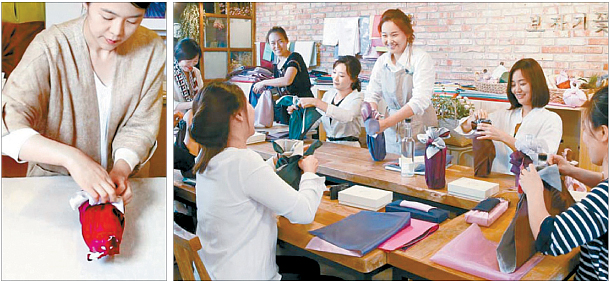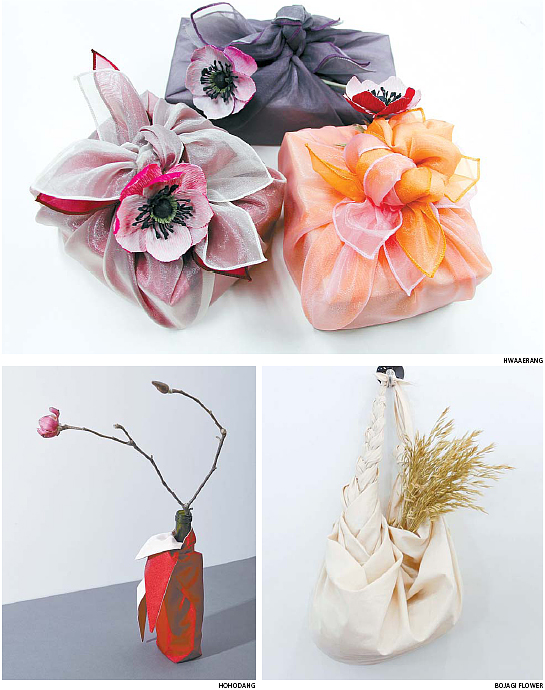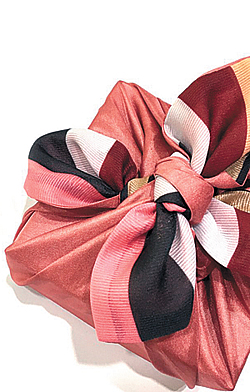‘Tis the season of stylish giving : Traditional Korean gift-wrapping makes a comeback, with class

“Doesn’t it sound more friendly when you say, ‘Untie the present,’ instead of ‘Tear off the wrapping?’” asks Lee Hyo-jae, a traditional clothing artist and bojagi pioneer. [LIM HYUN-DONG]
Not only it is a traditional style of wrapping, it can flexibly assume any shape to adequately cover whatever the present may be.
Thanks to its practicality and elegant beauty, bojagi is making a comeback. Lee Hyo-jae, a traditional clothing artist, is one of the first people to come to mind when speaking of bojagi, as she helped re-popularize the use of bojagi.
“Doesn’t it sound more friendly when you say, ‘Untie the present,’ instead of ‘Tear off the wrapping?’” asked Lee in an interview with JoongAng Ilbo, an affiliate of the Korea JoongAng Daily, at a hanok, or traditional Korean home, in Bukchon Hanok Village in central Seoul.
Lee wrote a mini pamphlet titled “How to wrap food with bojagi” in Woman JoongAng, a monthly magazine for female readers, in 2007.
“Before,” said Lee, “people thought of bojagi as an unsophisticated, rustic bundle to carry anything. But now, many use bojagi in various ways, while at the same time bringing attention to its elegance.”

Left: Yang Jung-eun of Hohodang is wrapping a bottle. Right: Lee Yun-yeong, the owner of “Bojagi Flower,” holds a bojagi class with her students. [LIM HYUN-DONG]
Vivid, rich and colorful bojagi immediately catch the eyes of shoppers in Hohodang, Cheongun-dong, central Seoul. Those who always thought of bojagi as a mere wrapping that just comes with the gift they buy may be a little confused to see a display of bojagi so beautiful they easily rival the very gifts they are meant to wrap.
One might understandably hesitate to fold a present up in a cloth that competes for attention, but looking at the variety of colors and materials available, it seems more than worth the risk. Besides, when one uses a bojagi, one is actually giving two gifts at once.
The price of a typical bojagi in Hohodang ranges from 30,000 won ($26.43) to 50,000 won.
Yang Jung-eun, CEO of Hohodang, is quite familiar with bojagi, as her parents made hanbok (traditional Korean dress) for period dramas for a living.
They used the leftover fabric to create bojagi, and as a result, Yang even carried her lunchbox, wrapped in the beautiful folds of a bojagi, to school every day as a child.
“To pack traditional food,” Yang said, “bojagi was essential, but after my parents retired, it was very difficult to find beautiful bojagi. I wasn’t able to find the perfect bojagi I wanted, in terms of design, fabric and price, so I became determined to make my own, and that’s how I ended up opening Hohodang.”
Yang first started her business three years ago in Gye-dong, and has been in Cheongun-dong for a year now, but the public’s reaction to her shop has been so much better than she initially expected that she recently decided to open another store at the Hyundai Department Store in Mok-dong, western Seoul.
Not only are younger generations getting in on the trend, they seem to be some of the biggest bojagi customers of all, as evidenced by around the 10,000 Instagram followers of Hohodang.
“We offer two types of bojagi,” Yang said. “We have a classic line for special days such as a first birthday or a marriage, and a more modern line for wrapping lunchboxes or simple presents.”
Yang added, “People who always had images of cheap bojagi from China or bojagi from rice cake houses come to change their image of bojagi as luxury decoration items after seeing high quality, colorful pieces.”
The reaction of companies were good, too. On the second floor of Sulwhasoo, a cosmetics store, in front of Dosan Park, southern Seoul, is a wrapping corner run by Hohodang.
The wrapping service there is well known for the luxurious quality of its goods. Also, several luxurious brands such as Dunhill and Valextra have requested that Hohodang help enrich their products as presents for their VIPs.
Earlier this year, Hohodang was even invited to Milan’s lifestyle trade fair, HOMI. Korea’s traditional wrapping proudly replaced the conventional plastic or paper shopping bags and were provided to shoppers at the fair.
“People tie ribbons easily, but have difficulty making a knot with bojagi,” said Yang. “I don’t want to necessarily make fancy knots with bojagi, but instead make fancy bojagi so that even the simple knot can be outstanding.”

A bojagi-class is held once a day at a bojagi school named “Bojagi Flower,” located near Gyeongbokgung Station, central Seoul.
It is a daylong course with either one-to-one tutoring or a small group tutoring format. Two hours in one day is enough to learn how to make a wide variety of knots with bojagi. Tuition is 200,000 won for one class, which includes assorted bojagi and 11 other materials. Classes are a success, and are typically full.
The class on Sept. 15, for example, was full of people taking expert courses. For Jang Yun-yeong, 37, it was her second time taking the expert course. She had taken four courses in May but registered again to master the skills.
“I wish to open a bojagi lecture for foreigners, so I decided to take the expert course,” Jang said. “I was able to learn faster by tutoring than studying how to make the various knots alone.”
Lee Yun-yeong, 37, owner of “Bojagi Flower,” first fell in love with bojagi 10 years ago when she was preparing for her child’s first birthday party.
“I had no place to learn bojagi knots,” said Lee, “so I studied by myself looking at knots. Now, as bojagi has become more common, there are many people who want to learn and teach bojagi styling.”
Lee teaches how to wrap objects such as tissue boxes, books or lunchboxes, which are used in people’s daily lives.
In particular, packaging wine bottles and pots that store food inside are both popular.
“The price of bojagi is more expensive than any typical paper wrapper, so some people think it is not quite reasonable but actually it is the opposite of that. Bojagi is very practical as it wraps anything and can be used several times,” told Lee.

The gift-wrapping studio Hwaaerang in Chungdam-dong, southern Seoul, has been busy with the long festival of Chuseok ahead.
This year, there were many orders for bojagi. The studio is run by Lim Hyun-sim and Hwang Seo-jin as double representatives, and they open small classes for packaging or take orders from other companies that need wrapping services.
“When people want luxurious wrapping, they prefer fabric over paper. So they often choose bojagi because the image of bojagi has been upgraded,” said Hwang.
There are many reasons for this, but mostly it is because bojagi itself has become prettier than before.
“Now there are many bojagi with modern gray or dark blue colors, and so on,” Hwang added,” as opposed to just the five common colors [blue, red, brown, black and white] previously found.”
“Accessibility to such luxurious bojagi has increased, and people seek bojagi even to wrap normal presents, not just traditional presents,” said Lim. When packing in Hwaaerang, they add decorations such as hand-made flowers, beads and jewelry, to add a modern flare to each wrapping.
In addition to wrapping with bojagi, interest in wrapping styles has also gone up in general.
“As the number of people who make homemade goods increases,” said Lim, “the number of people checking out wrapping styles naturally has increased as well.”
Opening a new era
Bojagi have become more charming item these days, and can even be used as decorative dress items, not only wrapping one’s wine but wrapping one’s neck in the brisk autumn air. All this has, inevitably, led to a certain level of competitiveness in the field.
On Sept. 13, a bojagi performance was held at the Press Center in central Seoul. Participants of the Green Asia Forum 2017 opened the event by untying the colorful knots of various bojagi, instead of cutting an opening-ceremony tape.
Designer Lee Hyo-jae had proposed the idea, as bojagi are reusuable, whereas tape is thrown away after it is cut.
For all these reasons and more, bojagi have returned to add a little color and class to our gift-giving rituals - and our lives.
BY YOO JI-YEON [hong.youkyoung@joongang.co.kr]
코리안 럭셔리 보자기 뜬다
추석 선물이 오고가는 요즘, 보자기가 유난히 더 눈에 띈다. 우리 고유의 포장법이기도 하거니와 과일 바구니부터 육류까지, 어떤 형태도 다 담아내기 때문이다. 이제는 실용성뿐 아니라 고급스러운 '담음새'로 아름다움까지 잡았다. 보자기 하나면 요리조리 접고 펴고, 이리저리 모양을 내며 그야말로 예술 작품같은 포장이 가능하다. 아예 수공예 배우듯 보자기 포장만 가르치고 배우는 이들도 늘어나고 있다. 당당한 '코리안 럭셔리'로 대접 받는 보자기, 그 변신의 이유를 알아봤다.
활용 늘어나는 ‘마법의 포장’
“선물 건넬 때 ‘뜯어봐’보다 ‘풀어봐’라는 말이 더 예쁘지 않나요?”
이효재 한복 디자이너(59)는 보자기를 얘기할 때 늘 등장하는 이름이다. 보자기의 아름다움을 상업적으로 대중에게 알린 첫 주자나 다름없다. 한복집을 경영하며 일상에서 늘 가까이했던 보자기의 아름다움을 혼자만 알기 아까워 한 월간지와 보자기 포장에 관한 책을 낸 것이 계기가 되었다. 2007년 ‘여성중앙’ 2월호 별책부록으로 출간했던 '보자기로 음식 싸는 법'에 관한 소책자는 전국 떡집에 깔려 마치 교본처럼 사용됐다. 이후 단행본 『효재처럼 보자기 선물(2008)』을 출간하면서 그의 보자기 포장법이 대중에게 더 널리 알려졌다.
이씨는 “당시만 해도 보자기라고 하면 못살던 시절 아무렇게나 짐을 넣어 다니던 보따리를 연상하고는 무조건 ‘촌스럽다’고 생각하는 사람들이 많았다”며 “요즘에는 보자기의 아름다움을 인정하고 다양하게 활용하려는 시도가 보여 반갑다”고 말했다.
현대적 디자인 감수성 자극하는 보자기
서울 종로구 청운동에 있는 ‘호호당’은 한국의 색이 담긴 물건을 파는 상점이다. 매장에 들어서면 한눈에 들어오는 것이 바로 고급 스카프처럼 걸려있는 색색의 보자기다. 보자기는 늘 물건에 딸려오거나 공짜라고만 알았던 이들이라면 조금 당황스러울 수 있겠다. 하지만 3만 원대부터5만 원대까지 다양한 소재와 배색으로 갖춰진 호호당의 보자기를 보고 있자면 하나쯤 소장하고픈 욕심이 생긴다.
호호당 양정은 대표(34)는 사극 의상을 제작하던 부모님 영향으로 어린 시절부터 늘 가까이에서 보자기를 접해왔다. 한복을 만들고 남은 천으로 보자기를 만들어 사용했기에 하다못해 도시락조차도 보자기로 감쌌다. 전통 음식을 전공한 후 이바지 음식 등 선물 요리를 가르치는 수업을 진행하거나 주문 의뢰를 받아 제작하는 일을 잠시 했는데, 그때 역시 빠질 수 없는 게 바로 보자기였다. 양 대표는 “전통 음식을 포장하려면 보자기가 꼭 필요했는데 부모님 은퇴 후에는 예쁜 보자기를 찾는 것이 참 어려웠다"며 "마음에 드는 색이나 소재, 합리적인 가격대의 보자기를 구하기 어려워 직접 만들어보겠다고 결심했다”며 호호당 문을 연 이유를 얘기했다.
3년 전 사업을 시작해 계동을 거쳐 지금의 청운동으로 매장을 옮긴지 1년 남짓인데 호응이 꽤 좋아 최근 현대백화점 목동점에도 매장을 열었다.
사람들이 정말로 보자기에 그렇게 관심이 많을까 믿기 어렵지만 의외로 그렇다. 특히 젊은 사람들일수록 오히려 호응이 좋은 편이다. 호호당 인스타그램 계정 팔로워 수는 1만명을 상회한다. 양 대표는 “돌이나 결혼 등 특별한 날에 활용할 수 있는 클래식 라인과 도시락 포장이나 간단한 선물 포장 등에 활용할 수 있는 모던 라인 두 가지로 전개한다”며 “중국에서 들여온 값싼 분홍색 보자기, 일명 떡집 보자기만 생각하던 사람들이 좋은 소재의 색색 보자기를 보고 아름답고 세련됐다고 생각하는 것 같다”고 인기 이유를 분석했다.
기업들의 호응도 좋다. 서울 도산공원 앞의 화장품 브랜드 설화수의 플래그십 스토어 2층에는 호호당이 참여한 포장 코너가 있다. 고급스러운 포장으로 유명한데 특히 외국인들이 즐겨 찾는다. 이외에도 럭셔리 패션 브랜드 발렉스트라나 던힐 등 해외 브랜드에서도 VIP를 위한 선물을 제작하거나 행사에 사용할 보자기 포장을 의뢰하는 경우도 많다.
2017년 초에는 이탈리아 밀라노 생활 소비재 박람회에 참여하기도 했다. 물건을 사는 이들에게 쇼핑백 대신 현장에서 보자기로 가방을 만들어 담아줬다. 덕분에 현지 바이어들 사이에서 ‘마법사’로 불리는 기분 좋은 해프닝도 겪었다. 양 대표는 “리본은 쉽게 묶으면서 보자기 매듭은 어려워하는 사람들이 많다”며 “보자기로 굳이 화려한 매듭을 지어 보여주기보다 가장 기본적인 매듭도 돋보일 수 있는 보자기를 꾸준히 만들고 싶다”고 했다.
뭐든 감싸는 매력에 보자기 배우는 사람들
서울 경복궁역 근처의 ‘보자기꽃’ 아트 스쿨에서는 하루에 한 번씩 보자기 클래스가 열린다. 1대 1 강의나, 2~5명 정도의 소규모 수업으로 이루어지는 원 데이(one-day) 클래스로, 하루 두 시간이면 웬만한 보자기 활용 포장법은 모두 익힐 수 있다. 수강료가 한 회에 20만원(보자기 제공, 11가지 물품 포함)으로 적지 않은 비용이지만 수업은 늘 만원이다.
강의가 한창이던 지난 9월 15일 오후에 보자기꽃에 들렀다. 이날은 초보자가 아닌 전문가 과정을 듣는 이들로 북적였다. 수강생 장윤영(37)씨는 벌써 두 번째 전문가 과정을 듣고 있다. 지난 5월 월 4회 수업을 들었는데 더 완벽하게 마스터하기 위해 한 번 더 신청했다고 한다. “앞으로 외국인들을 대상으로 보자기 강의를 하고 싶어서 전문가 과정의 문을 두드렸다”며 “보자기 매듭을 혼자서 연구해가며 익히는 것보다 강의를 통해 빠르게 익힐 수 있어 좋다”고 말했다.
보자기꽃을 운영하는 이윤영(37) 보자기 아티스트는 10여 년 전 자녀 돌상을 손수 차리다가 보자기의 매력에 빠졌다. 이 대표는 “10년 전만에도 보자기 배울 곳이 없어서 혼자서 매듭을 보며 연구했다”며 “지금은 보자기가 비교적 많이 대중화해서 가르치거나 배우려는 사람이 많다”고 말했다.
이 대표는 생활에 필요한 보자기 포장법을 중심으로 가르친다. 대단하고 거창한 선물이 아니라 책아니 각티슈, 도시락 포장 같은 것 말이다. 특히 와인병이나 뚝배기·냄비 등에 음식을 넣은채 그대로 싸서 선물하는 포장법 등 실생활에서 활용하기 쉬운 보자기 포장법에 대한 호응이 높다. 이 대표는 “처음 구입할 때는 포장지보다 고가이기 때문에 실용적이지 않다고 생각하는 사람이 있는데 오히려 그 반대”라며 “여러 번 재사용할 수 있을 뿐 아니라 어떤 물건이든 그 모양 그대로 자연스럽게 포장할 수 있어 오히려 활용도가 높다”고 보자기의 장점을 얘기했다.
아름답게 만드는 마법같은 포장
서울 청담동 인근의 '화애랑' 포장 스튜디오는 추석을 앞두고 바쁜 일정을 보내고 있다. 올해 유난히 보자기를 활용한 포장 의뢰가 많았다. 임현심(41)·황서진(36) 두 공동 대표가 운영하는 이 포장전문업체는 소규모 포장 클래스를 운영하거나 업체 의뢰를 받아 포장을 진행한다. 황 대표는 “요즘은 고급스러운 포장을 원할 때 종이보다 패브릭(fabric·천)을 찾는 경우가 많다”며 “천 중에서도 보자기를 많이 찾는 건 보자기를 고급스럽게 바라보는 쪽으로 인식이 달라졌기 때문”이라고 분위기를 전했다.
여러 가지 이유가 있지만 무엇보다 보자기 자체가 예전과 비교할 수 없을 만큼 예뻐진 게 큰 역할을 했다. 황 대표는 “예전 보자기처럼 오방색이나 청홍색 등 화려한 색이 아니라 모던한 회색이나 짙은 남색 등 톤이 다운된 세련된 컬러의 보자기가 많아졌다"며 "이런 세련된 컬러의 보자기를 쉽게 접할 수 있게 되면서 꼭 전통 물품이 아닌 일반 선물을 포장해도 근사한 느낌이 드니 많이들 찾는 것”이라고 말했다. 화애랑에서는 전통 보자기 포장에 수공예로 만든 종이 꽃이나 비즈 장식, 주얼리 장식 등을 더해 현대적인 느낌을 더하곤 한다.
꼭 보자기 포장만이 아니라 전반적으로 포장에 대한 관심 자체가 높아진 것도 보자기의 인기에 한몫했다. 인스타그램등 사진 기반의 소셜미디어(SNS)의 영향으로 인증샷을 위한 패키지 포장에 관심을 기울이는 분위기가 만들어진 것이다. 자연스러운 것이 멋으로 여겨지는 트렌드 덕분에 보자기의 단아하면서도 고급스러운 매력을 높게 사는 이들이 많다. 임 대표는 “수제청·수제비누 등 수공예 인구가 늘어나면서 포장법에 더 관심을 기울이게 됐다”고 분석하기도 했다.
에르메스 스카프도 보자기로 활용
보자기가 전보다 한층 예쁘고 고급스러워졌지만 실은 훨씬 더 럭셔리하게 활용할 수도 있다. 갖고 있는 스카프 등을 보자기로 쓰는 방법이다. 일회성이 아니라 얼마든지 재활용할 수 있기에 가능한 시도다.
지난 9월 13일 서울 중구 프레스센터에서는 이를 응용한 색다른 보자기 퍼포먼스가 열렸다. 2017 그린 아시아포럼 공식만찬 행사에서 참여자들이 테이프 대신 보자기 매듭으로 커팅식을 연 것이다. 평소처럼 테이프를 가위로 자르는 게 아니라 매듭으로 이어진 색색의 보자기를 풀어내는 방식이었다. 자르고 나면 버려야 하는 리본 테이프 대신 재활용이 가능한 보자기를 활용했다. 이 보자기 퍼포먼스는 이효재 디자이너의 아이디어였다.
손잡이를 만들면 가방이 되고 자리에 펼치면 깔개가 된다. 일상에서 이만큼 활용하기 좋은 게 또 없다. 보자기가 다시 일상으로 들어온 이유다.
유지연 기자










with the Korea JoongAng Daily
To write comments, please log in to one of the accounts.
Standards Board Policy (0/250자)